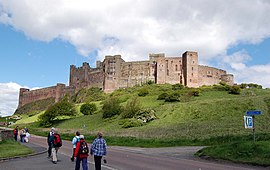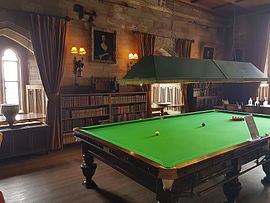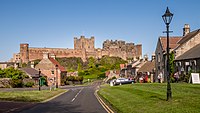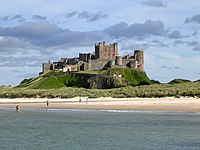signed with initials "LWT"
Tom and Laura Taylor and thence by descent
| Bamburgh Castle | |
|---|---|
| Bamburgh, Northumberland | |

Bamburgh Castle from the southwest |
|
Bamburgh Castle is a castle on the northeast coast of England, by the village of Bamburgh in Northumberland. It is a Grade I listed building.
The site was originally the location of a Celtic Brittonic fort known as Din Guarie and may have been the capital of the kingdom of Bernicia from its foundation c. 420 to 547. In that last year, it was captured by King Ida of Bernicia. After passing between the Britons and the Anglo-Saxons three times, the fort came under Anglo-Saxon control in 590. The fort was destroyed by Vikings in 993, and the Normans later built a new castle on the site, which forms the core of the present one. After a revolt in 1095 supported by the castle's owner, it became the property of the English monarch.
In the 17th century, financial difficulties led to the castle deteriorating, but it was restored by various owners during the 18th and 19th centuries. It was finally bought by the Victorian era industrialist William Armstrong, who completed its restoration. The castle still belongs to the Armstrong family and is open to the public.
history
The southwestern face of Bamburgh Castle, seen from ground level (top) and from above (bottom)
Medieval history
Built on top of a black crag of volcanic dolerite, and part of the Whin Sill, the location was previously home to a fort of the indigenous Celtic Britons known as Din Guarie. It may have been the capital of the kingdom of Bernicia, the realm of the Gododdin people, from the realm's foundation c. 420 until 547, the year of the first written reference to the castle. In that year the citadel was captured by the Anglo-Saxon ruler Ida of Bernicia (Beornice) and became Ida's seat.
The castle was briefly retaken by the Britons from his son Hussa during the war of 590 before being retaken later the same year. Circa 600, Hussa's successor Æthelfrith passed it on to his wife Bebba, from whom the early name Bebbanburh was derived. Vikings destroyed the original fortification in 993.

The Normans built a new castle on the site, which forms the core of the present one. William II unsuccessfully besieged it in 1095 during a revolt supported by its owner, Robert de Mowbray, Earl of Northumbria. After Robert was captured, his wife continued the defence until coerced to surrender by the king's threat to blind her husband.
Bamburgh then became the property of the reigning English monarch. Henry II probably built the keep as it was complete by 1164. Following the Siege of Acre in 1191, and as a reward for his service, King Richard I appointed Sir John Forster the first Governor of Bamburgh Castle. Following the defeat of the Scots at the Battle of Neville's Cross in 1346, King David II was held prisoner at Bamburgh Castle.
During the civil wars at the end of King John's reign, the castle was under the control of Philip of Oldcoates. In 1464 during the Wars of the Roses, it was subject to a nine-month siege by Richard Neville, 16th Earl of Warwick, the "Kingmaker", on behalf of the Yorkists which was marked by the extensive use of artillery.
Modern history
The State Rooms of Bamburgh Castle; in top-centre of middle image, The Card Players, by Theodoor Rombouts, c. 1630
The Forster family of Northumberland continued to provide the Crown with successive governors of the castle until the Crown granted ownership (or a lease according to some sources) of the church and the castle to another Sir John Forster in the mid-1500s, after the Dissolution of the Monasteries. The family retained ownership until Sir William Forster (d. 1700) was posthumously declared bankrupt, and his estates, including the castle, were sold to Lord Crew, Bishop of Durham (husband of his sister Dorothy) under an Act of Parliament to settle the debts in 1704.
Crewe placed the castle in the hands of a board of trustees chaired by Thomas Sharp, the Archdeacon of Northumberland. Following the death of Thomas Sharp, leadership of the board of trustees passed to John Sharp (Thomas Sharp's son) who refurbished the castle keep and court rooms and established a hospital on the site. In 1894, the castle was bought by the Victorian industrialist William Armstrong, who completed the restoration.
During the Second World War, pillboxes were established in the sand dunes to protect the castle and surrounding area from German invasion and, in 1944, a Royal Navy corvette was named HMS Bamborough Castle after the castle.The castle still remains in the ownership of the Armstrong family.
After the War, the castle became a Grade I Listed property. The description included this comment about the status of the building in 1952 and its history:
Castle, divided into apartments. C12; ruinous when acquired by Lord Crewe in 1704 and made habitable after his death by Dr. Sharpe ... Acquired by Lord Armstrong, who had extensive restoration and rebuilding of high quality by C.J. Ferguson, 1894-1904. Squared sandstone and ashlar.
Location

About 9 miles (14 km) to the south on a point of coastal land is the ancient fortress of Dunstanburgh Castle and about 5 miles (8 km) to the north is Lindisfarne Castle on Holy Island. Inland about 16 miles (26 km) to the south is Alnwick Castle, the home of the Duke of Northumberland.
Environmental factors
Air quality levels at Bamburgh Castle are excellent due to the absence of industrial sources in the region. Sound levels near the north–south road passing by Bamburgh Castle are in the range of 59 to 63 dBA in the daytime (Northumberland Sound Mapping Study, Northumberland, England, June 2003). Nearby are breeding colonies of Arctic and common terns on the inner Farne Islands, and of Atlantic puffin, European shag and razorbill on Staple Island.
Archaeology at Bamburgh
Archaeological excavations were started in the 1960s by Brian Hope-Taylor, who discovered the gold plaque known as the Bamburgh Beast as well as the Bamburgh Sword. Since 1996, the Bamburgh Research Project has been investigating the archaeology and history of the Castle and Bamburgh area. The project has concentrated on the fortress site and the early medieval burial ground at the Bowl Hole, located in sand dunes to the south of the castle, evidence of which had first been revealed in a storm of 1817.
During excavations at the Bowl Hole between 1998 and 2007, the remains of 120 individuals from the 7th and 8th century were discovered in that graveyard. The research project was led by Professor Charlotte Roberts of Durham University, and found remains of individuals who had originated from Ireland, Scotland, Scandinavia, the Mediterranean and North Africa.
Finally, in 2016, they were moved into the crypt of St Aidan's Church, Bamburgh; the crypt can be viewed by visitors through a small gate.
The castle's laundry rooms feature the Armstrong and Aviation Artefacts Museum, with exhibits about Victorian industrialist William Armstrong and Armstrong Whitworth, the manufacturing company he founded. Displays include engines, artillery and weaponry, and aviation artefacts from two world wars.
Bamburgh Castle was a civil parish, in 1951 the parish had a population of 18. Bamburgh Castle was formerly a township in Bambrough parish, from 1866 Bamburgh Castle was a civil parish in its own right until it was abolished on 1 April 1955 and merged with Bamburgh.

Selected literary appearances
The castle features in the ballad The Laidly Worm of Spindleston Heugh written in circa 1270. Late medieval British author Thomas Malory identified Bamburgh Castle with Joyous Gard, the mythical castle home of Sir Launcelot in Arthurian legend.
In literature, Bamburgh, under its Saxon name Bebbanburg, is the home of Uhtred Uhtredson, the main character in Bernard Cornwell's The Saxon Stories. It features either as a significant location or as the inspiration for the protagonist in all books in the series, starting with The Last Kingdom, and the sequels The Pale Horseman, The Lords of the North, Sword Song, The Burning Land, Death of Kings, The Pagan Lord, The Empty Throne, Warriors of the Storm, The Flame Bearer, War of the Wolf, Sword of Kings and War Lord.
The castle and also the village provide the setting for the crime novel Bamburgh authored by LJ Ross.
Selected film and television appearances
In addition to appearances as itself, Bamburgh Castle has been used as a filming location for a number of television and film projects:
- 1927: Huntingtower
- 1949: A Connecticut Yankee in King Arthur's Court
- 1964: Becket
- 1971: The Devils
- 1971: Macbeth
- 1971: Mary, Queen of Scots
- 1982: Ivanhoe
- 1984–86: Robin of Sherwood
- 1998: Elizabeth
- 2011: Channel 4's Time Team dig at Bamburgh Castle
- 2015: Macbeth (film)
- 2018: The Last Kingdom (TV series)
- 2023: Indiana Jones and the Dial of Destiny
Laura Wilson Barker (6 March 1819 – 22 May 1905), was a composer, performer and artist, sometimes also referred to as Laura Barker, Laura W Taylor or "Mrs Tom Taylor".
She was born in Thirkleby, North Yorkshire, third daughter of a clergyman, the Rev. Thomas Barker. She studied privately with Cipriani Potter and became an accomplished pianist and violinist. As a young girl Barker performed with both Louis Spohr and Paganini. She began composing in the mid-1830s - her Seven Romances for voice and guitar were published in 1837. From around 1843 until 1855 she taught music at York School for the Blind. During this period some of her compositions - including a symphony in manuscript, on 19 April 1845 - were performed at York Choral Society concerts.
On 19 June 1855 she married the English dramatist, critic, biographer, public servant, and editor of Punch magazine Tom Taylor. Barker contributed music to at least one of her husband's plays, an overture and entr'acte to Joan of Arc (1871), and provided harmonisations as an appendix to his translation of Ballads and Songs of Brittany (1865).
Her other works include the cantata Enone (1850), the violin sonata A Country Walk (1860), theatre music for As You Like It, (April 1880), Songs of Youth (1884), string quartets, madrigals and solo songs. Her choral setting of Keats's A Prophecy, composed in 1850, was performed for the first time 49 years later at the Hovingham Festival in 1899. The composer was present.
Several of Barker's paintings hang at Smallhythe Place in Kent, Ellen Terry's house.
Barker lived with her husband and family at 84 Lavender Sweep, Battersea. There were two children: the artist John Wycliffe Taylor (1859–1925), and Laura Lucy Arnold Taylor (1863–1940). The Sunday musical soirees at the house attracted many well-known attendees, including Lewis Carroll, Charles Dickens, Henry Irving, Charles Reade, Alfred Tennyson, Ellen Terry and William Makepeace Thackeray.
Tom Taylor died suddenly at his home in 1880 at the age of 62. After his death, his widow retired to Porch House, Coleshill in Buckinghamshire, where she died on 22 May 1905, aged 86.










